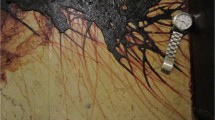Abstract
In May 1845 HMS Terror and HMS Erebus left England under the command of Sir John Franklin to find the Northwest Passage linking the north Atlantic and Pacific Oceans. The ships had been specially equipped for arctic conditions with central heating, auxiliary steam engines and reinforced steel bows to cut through the ice, however, despite these modern additions neither the vessels nor any of the 129 crew members would ever return. Recently the wrecks of the ships have been located in the waters around King William Island, Nunavut, Canada. Numerous theories have been advanced to explain the deaths that involve lead poisoning, scurvy and zinc deficiency. It is most likely, however, that the deaths were the result of multiple factors such as starvation, hypothermia, infection and general physical and mental decline. Cannibalism occurred but whether this involved the use of already dead sailors or the culling of the weak for food is not determinable. The essential point is that the crews were trapped in the Arctic, many thousands of miles from their homes and families, with dwindling food supplies and minimal chances of rescue.






Similar content being viewed by others
References
Franklin LA. Tragic hero of polar navigation. London: Faber and Faber; 2009.
Walch’s Tasmanian Almanac. Hobart: J. Walch & Sons; 1896.
The Encyclopaedia Britannica – A dictionary of arts, sciences and general literature. 9th ed, Vol IX. Edinburgh: Adam and Charles Black; 1879.
West J. The history of Tasmania. Angus and Robertson Pty Ltd: Sydney; 1971.
Alexander A. The companion to Tasmanian history. Centre for Tasmanian Historical Studies: Hobart; 2005.
Bayliss R. Sir John Franklin’s last arctic expedition: a medical disaster. J Roy Soc Med. 2002;95:151–3.
Beattie O, Geiger J. Frozen in time. Unlocking the secrets of the Franklin expedition. New York: E.P. Dutton; 1987.
Franklin expedition ship found in Arctic ID'd as HMS Erebus. CBC News. 1 October 2014. https://www.cbc.ca/news/politics/franklin-expedition-ship-found-in-arctic-id-d-as-hms-erebus-1.2784268. Accessed 8 Aug 2020.
Watson P. Ship found in Arctic 168 years after doomed Northwest Passage attempt. The Guardian. 12 September 2016. https://www.theguardian.com/world/2016/sep/12/hms-terror-wreck-found-arctic-nearly-170-years-northwest-passage-attempt#:~:text=The%20long%2Dlost%20ship%20of,of%20polar%20exploration%27s%20deepest%20mysteries. Accessed 8 Aug 2020.
Horowitz BZ. Polar poisons: did botulism doom the Franklin expedition? J Tox. 2003;41:841–7.
Kane EK. Arctic explorations in search of sir John Franklin. T. Nelson and Sons: Edinburgh; 1894.
Keenleyside A, Bertulli M, Fricke HC. The final days of the Franklin expedition – new skeletal evidence. Arctic Mag. 1997;50:36–46.
Mays S, Beattie O. Evidence for end stage cannibalism in sir John Franklin’s last expedition to the Arctic, 1845. Int J Osteoarchaeol. 2016;26:778–86.
Amy R, Bhatnagar R, Damkjar E, Beattie O. The last Franklin expedition: report of a postmortem examination of a crew member. Can Med Assoc J. 1986;135:115–7.
Byard RW, Bright F, Winskog C. Reduced body mass index and lethal hypothermia. Aust J Forensic Sci. 2014;46:451–4.
Stephenson L, Byard RW. An atlas overview of characteristic features of tuberculosis that may be encountered at autopsy. Forensic Sci Med Pathol. 2020;16:143–51.
Byard RW. Adipocere – the fat of graveyards. Am J Forensic Med Pathol. 2016;37:208–10.
Bright F, Winskog C, Byard RW. Wischnewski ulcers and hypothermia – sensitive, specific or serendipitous? Forensic Sci Med Pathol. 2013;9:88–90.
Stenton D, Keenleyside A, Park RW. The “boat place” burial: new skeletal evidence from the 1845 Franklin expedition. Arctic. 2015;68:32–44.
Stenton DR, Park RW. History, oral history and archaeology: reinterpreting the "boat places" of Erebus bay. Arctic. 2017;70:203–18.
Byard RW, Maxwell-Stewart H. Cannibalism amongst penitentiary escapees from Sarah Island in nineteenth century Van Diemen’s land. Forensic Sci Med Pathol. 2018;14:410–5.
Beattie OB, Savelle JM. Discovery of human remains from sir John Franklin’s last expedition. Hist Archaeol. 1983;17:100–5.
Mays S, Maat GJR, de Boer HH. Scurvy as a factor in the loss of the 1845 Franklin expedition to the Arctic: a reconsideration. Int J Osteoarchaeol. 2015;25:334–44.
Battersby W. Identification of the probable source of the lead poisoning observed in members of the Franklin expedition. J Hakluyt Soc. 2008:1–10.
Farrer KTH. Lead and the last Franklin expedition. J Archeol Sci. 1993;20:399–409.
Martin RR, Naftel S, Macfie S, Jones K, Nelson A. Pb distribution in bones from the Franklin expedition; synchrotron X-ray fluorescence and laser ablation/mass spectroscopy. Appl Phys A Mater Sci Process. 2013;111:23–9.
Millar K, Bowman AW, Battersby W. A re-analysis of the supposed role of lead poisoning in sir John Franklin's last expedition, 1845–1848. Polar Rec. 2015;51:224–8.
Swanston T, Varney TL, Kozachuk M, Choudhury S, Bewer B, Coulthard I, et al. Franklin expedition lead exposure: new insights from high resolution confocal x-ray fluorescence imaging of skeletal microstructure. PLoS One. 2018;13:e0202983.
Christensen JR, McBeth JM, Sylvain NJ, Spence J, Chan HMJ. Hartnell's time machine: 170-year-old nails reveal severe zinc deficiency played a greater role than lead in the demise of the Franklin expedition. J Archaeol Sci Rep. 2017;16:430–40.
Byard RW, Maxwell-Stewart H. Scurvy – characteristic features and forensic issues. Am J Forensic Med Pathol. 2019;40:43–6.
Author information
Authors and Affiliations
Corresponding author
Additional information
Publisher’s note
Springer Nature remains neutral with regard to jurisdictional claims in published maps and institutional affiliations.
Rights and permissions
About this article
Cite this article
Byard, R.W. Death in the Arctic – the tragic fate of members of the Franklin expedition (1845). Forensic Sci Med Pathol 17, 161–166 (2021). https://doi.org/10.1007/s12024-020-00305-5
Accepted:
Published:
Issue Date:
DOI: https://doi.org/10.1007/s12024-020-00305-5




